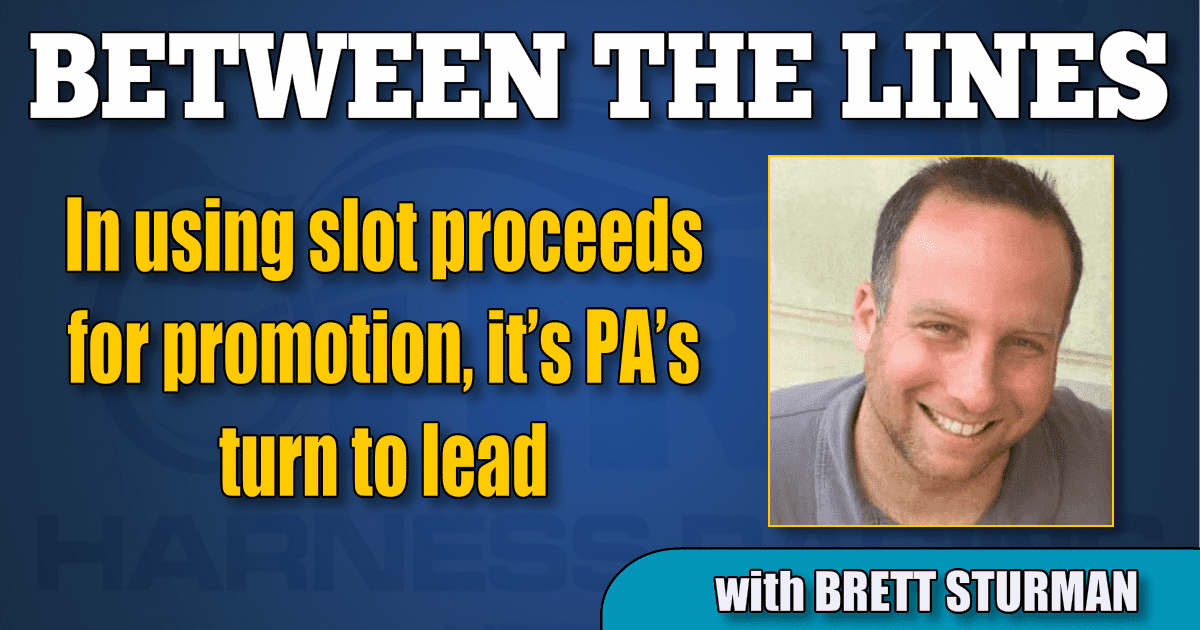
In using slot proceeds for promotion, it’s PA’s turn to lead
by Brett Sturman
This week, an update was provided on marketing and branding efforts resulting from slot revenues specifically earmarked for promotion in the state of Pennsylvania. Tracking the initiatives and their degrees of success is critical because other jurisdictions may soon find themselves needing to follow the Pennsylvania model.
For background, some industry leaders have long called for a fund to be created where a small percentage of gaming revenues would be redirected from purses to the betterment of the sport (i.e. marketing and integrity). In the case of PA, the new fund wasn’t initiated by the industries representatives in the state, but rather it was mandated by the state government as a way for the industry to advance itself.
In 2017, the harness industry in the state was nearly shut down because it didn’t have enough money for regulation due to decreased handle. As a result, a new reform was enacted and one per cent of money that went to the racing and development fund, that among other things enhanced the races purses, will now go directly to pay for drug testing and promotion.
The horse race development fund in PA comes out to about $250 million per year, so one per cent of the fund would equate to roughly $2.5 million. The good news is that a fund solely towards marketing and integrity has been established and is now being used, but the real question is, what next?
From a marketing standpoint, having the funds to use is only as good as the ability to execute successful promotional initiatives. Racetracks and horsepeople groups already market with other more limited funds, but with questionable results. To date, ongoing efforts that stem directly from the new fund include the creation of a centralized website, engagement with patrons and Pocono Downs and PA county fairs, and advertisement at the Pittsburgh Penguins hockey arena following research that evidently shows a potential relationship between hockey fans and harness racing.
It’s to be seen if these efforts will work, but they don’t seem much different than things that have been tried in the past. When there had been talk in the industry previously about the need to create marketing funds, there was a belief that promotion would be best left to an external firm. Or, as an alternative to commonly attempted marketing techniques, what about using a portion of the fund to help offset the state’s notoriously high takeout rates? Doing so wouldn’t bring in new people, but it might get existing people get back to wagering.
The fund for promotion and integrity is certainly a good thing, but it’s now more important than ever that it is successful because the state will be expecting results on the reform. Such is the case in neighboring state New Jersey, a state that recently received a new $100 million subsidy. As part of that deal, tracks must submit an annual report showing the impact of the subsidies on wagering and revenue. From that point, state lawmakers can decide not to allocate future portions of the subsidy if industry gains have been inadequate.
The pressure is on to produce because in states like PA, the state legislature is always looking at the race horse development fund. Whenever budget negotiations arise, the question always becomes should public funds be used to support the racing industry. If handle and revenue increase along with more stringent regulatory rules, then at least racing in these states can continue receiving subsidies. But if the latest reform to assist with the area’s most in need doesn’t work, then future subsidies could be in real jeopardy.
While the need to produce results is critical, this is also an opportunity for PA to lead and to help show the way. With roughly $2.5 million per year to spend on promotion and integrity on top of what is already being spent on those items, PA will have every chance to be successful at its initiatives. And if there are elements of success, they could provide a blueprint for other states to follow. The state already has the most attractive breeding program and race purses anywhere in the country, and now is the opportunity to address the other areas of revenue and perceived integrity issues.
It’s hard to think that as Pennsylvania goes so goes the industry, but there’s no question that what goes on in PA is being watched in other jurisdictions. If advances are made in revenue and integrity, then others will be able to follow suit. Conversely, if a way is found to take away subsidies in the state then other states will surely take note of that also.
Those in power in the various horsemen groups and racing commission in the state are excited to now be able to reach out and spread the word of the potential of PA harness racing. Here’s hoping they are successful in that goal.












